Services on Demand
Journal
Article
Indicators
-
 Cited by SciELO
Cited by SciELO -
 Access statistics
Access statistics
Related links
-
 Similars in
SciELO
Similars in
SciELO
Share
Revista de Ciências Agrárias
Print version ISSN 0871-018X
Rev. de Ciências Agrárias vol.42 no.1 Lisboa Mar. 2019
https://doi.org/10.19084/RCA.15237
ARTIGO
Accelerated aging periods and its effects on electric conductivity of popcorn seeds
Períodos de envelhecimento acelerado e seus efeitos na condutividade elétrica em sementes de milho pipoca
Heloisa Caroline Kavan1, Hugo César Rodrigues Moreira Catão1,*, Franciele Caixeta2, Cristiane da Silva Rocha1 and Ítala Menegon Castilho3
1Faculdade Gammon, Department of Plant Sciences, R. Prefeito Jayme Monteiro, 791, CEP 19700-000, Paraguaçu Paulista, SP, Brasil
2 General Mills Brasil Alimentos Ltda., R. Benjamin Constant, 17, CEP 86390-000, Cambará - PR, Brasil
3 Faculdades Integradas de Ourinhos, Rodovia BR 153, Km 338, CEP 19909-100, Ourinhos, SP, Brasil
(*E-mail: hugocatao@yahoo.com.br)
ABSTRACT
The production of popcorn has an increasing demand and requires the use of vigorous seeds. The accelerated aging test is used to evaluate seeds vigor, promoting the disruption of the membrane system. The disruption of membranes can be evaluated by the electrical conductivity test. The objective of this study was to evaluate the effects caused by different periods of accelerated aging and the ions in the exudate of the electrical conductivity test and its interactions with the physiological quality of popcorn seeds. The experimental design was completely randomized with seeds being submitted to eight accelerated aging periods (zero, 24, 48, 72, 96, 120, 144 and 168 hours). Water content (%), first count of germination (%), final germination (%), germination speed index, electrical conductivity (μS cm-1 g-1) and length of aerial portion and primary roots of seedlings were evaluated. The germination and vigor of popcorn seeds and the amount of leachate in the electrical conductivity test were influenced by the increasing exposure period to accelerated aging. The period of 72 hours of exposure to accelerated aging produces results that reflect on the vigor potential and leachate of the seeds.
Keywords: Zea mays var. everta; physiological quality; vigor.
RESUMO
A produção de milho pipoca é crescente e necessita do uso de sementes vigorosas. O teste de envelhecimento acelerado é usado para avaliar o vigor de sementes, promovendo a desintegração do sistema de membranas. A desintegração das membranas pode ser avaliada pelo teste de condutividade elétrica. Assim, objetivou-se avaliar os efeitos causados por diferentes períodos de envelhecimento acelerado e iões no exsudato do teste de condutividade elétrica e as suas relações com a qualidade fisiológica de sementes de milho pipoca. O delineamento experimental foi inteiramente casualizado, sendo que as sementes foram submetidas a oito períodos de envelhecimento acelerado (zero, 24, 48, 72, 96, 120, 144 e 168 horas) e avaliadas quanto teor de água (%), primeira contagem de germinação (%), germinação final (%), índice de velocidade de germinação, condutividade elétrica (μS cm-1 g-1) e comprimentos da parte aérea e da raiz primária das plântulas. A germinação e vigor de sementes de milho pipoca e a quantidade de lexiviados no teste da condutividade elétrica foram influenciados pelo aumento do período de exposição ao envelhecimento acelerado. Este, a partir de 72 horas, produz resultados que se refletem no potencial de vigor e lexiviados das sementes.
Palavras-chave: Zea mays var. everta, qualidade fisiológica, vigor.
INTRODUCTION
Popcorn (Zea mays L. var. everta) production is increasing due to its advantages as an income resource for farmers due to its aggregated value in the market. Such increase derives, in part, from the selection, development and adaptation of imported cultivars to the climatic conditions in Brazil (Catão & Caixeta, 2017). To increase the probabilities of success for this crop, the use of seeds with high physiological potential come to be preeminent for the establishment of plantations.
Seed quality influences significantly the establishment of a crop, especially under environmental stress conditions. Thus, seed technology has sought to improve tests used to evaluate the physiological potential (germination and vigor) of seeds, aiming the results may express the performance potential of the lot (Dutra & Vieira, 2004) and minimize the risk of using low quality seeds.
All characteristics from a seed lot may be evaluated trough diverse tests which follow strict standards. Habitually, seed quality is evaluated by the standard test of germination, performed under environmental controlled conditions. However, results from this test overestimate the real values of plant emergence in the field, although information regarding the vigor of seeds is also an essential information which must be accessed through seeds tests (Bertolin et al., 2011). Seed vigor tests constitute more sensitive quality indices than the standard seed germination test (Copeland & McDonald, 2001).
Among various seeds vigor tests, accelerated aging is one of the most used in Brazil and worldwide. This test has been abundantly studied and recommended for several species and has also been included in quality control programs from various seed producing companies (Guiscem et al., 2010). This test has as a principle the considerable increase of deterioration rate in seeds when exposed to high levels of temperature and relative humidity of the air, considered as the predominant environmental factors of intensity and velocity of deterioration (Binotti et al., 2008; Ohlson et al., 2010). Thus, the disruption of the membrane system occurs, and seeds deteriorate faster.
To evaluate the integrity of the membrane system the electric conductivity test is recommended. The electric conductivity test is a fast method to evaluate seed vigor. This test is widely used by many companies to compare seed vigor and consequently, the storage potential of corn seed lots (Vazquez et al., 2014). The value of electric conductivity in the soaking solution of seeds reflects the quantity of leachates in the exudates of the test, which are directly associated with the integrity of cell membranes.
The higher the value of the electric conductivity, the lower will be the vigor of the seed, once the higher quantity of leachates in the exudate test of electric conductivity occurs as a result of the loss of integrity from cell membranes, damaged cells, poor structured membranes or loss of cellular components, reducing the cell reparation ability in seeds, in addition to retarding the re-structuration of membranes during soaking (Binotti et al., 2008).
In such context, the electric conductivity of seeds soaking water, is among the most commonly used tests, due to its advantages, such as the detection of the first symptoms of deterioration in seeds, that is, the loss of structural integrity in cell membranes (Silva et al., 2014). Therefore, this test may be used to identify and to verify the deterioration level of seeds after being submitted to a test of accelerated aging. Given such perspective, the objective of the present work was to evaluate the effects caused by different accelerated aging periods and ions in the exudate of the electric conductivity test and its association with the physiological quality of popcorn seeds.
MATERIALS AND METHODS
This work was performed in the Laboratory for Seeds from the Department of Plant Sciences at Faculdades Gammon, in Paraguaçu Paulista, state of São Paulo, Brazil. To perform the experiments seeds of Zea mays L. var. everta, hybrid AP8203, produced by the AG Alumini Seeds in the 2016 harvest in Indiana, U.S.A., were used. Seeds were donated by the General Mills Brazil Foods Ltda., located in Cambará, state of Parana, Brazil. The initial quality of seeds was evaluated by means of tests of water content (%), first germination count (%), final germination (%), germination speed index and electric conductivity test.
For the accelerated aging test, a complete random design was used. Popcorn seeds were submitted to eight aging periods (zero, 24, 48, 72, 96, 120, 144 and 168 hours) and then were evaluated regarding its water content (%), first germination count (%), final germination (%), germination speed index, electric conductivity (μS cm-1 g-1) and length of the aerial portion and length of primary roots from seedlings.
The test was completed with four sub-samples of 50 seeds for each treatment, by the gerbox method as described by Marcos Filho (1999). Seeds were set over a metallic stainless mesh inside plastic gerbox boxes containing 40 mL of distilled water. After boxes were closed with their plastic caps, they were transferred to germination chamber regulated at a temperature of 42±0.5ºC, where they remained for a period according to the treatment: zero, 24, 48, 72, 96, 120, 144, 168 hours. After each period finished, seeds were submitted to the following tests.
Water content (WC): determined by the oven method at 105 (+ 3ºC) during 24 hours, using two samples for each treatment, according methodology proposed by the Rules for Seed Analysis (Brasil, 2009) and the results were expressed as percentage; Test of first count of germination (FCG) and final germination (GERM): performed with 4 sub-samples with 50 seeds in rolls of Germitest paper, in a germination chamber set at a constant temperature of 25oC. The paper was moistened with distilled water, with a quantity equivalent to 2.5 times the weight of the dry paper, to standardize the test. The first count was performed 4 days after sowing the paper and the final germination count 7 days after sowing, according to the criteria established by the Rules for Seed Analysis (Brasil, 2009); Germination speed index (GSI): performed simultaneously to the germination test, calculating every day and in the same schedule, the number of germinated seeds. Seeds were considered as germinated when exhibiting protruded radicle. The indexes were calculated according to the formula proposed by Maguire (1962); Electric conductivity (EC): performed with four sub-samples of 50 seeds weighted with a precision of three decimal units and later set in a plastic pot (200 mL capacity), containing 75 mL of deionized water and then set in a germination chamber BOD at 25oC for 24 hours. After that, the electric conductivity was measured in the soaking solution using a conductivity meter (TECNAL Tec-4MP) with electrode constant 1. Data were transformed in (µS cm-1 g-1); Length of the aerial portion and the primary root in seedlings: 20 seeds were set in pre-moistened substrate paper (as performed for the germination test) aligned in two longitudinal rows (10 seeds over each line) uniformly interspaced, with 4 replicates per treatment. Rolls were wrapped in plastic bags and set in germination chamber at 25oC. The length of the primary root and the length of the hypocotyl in normal seedlings were measured 4 days after with the aid or a ruler regulated in centimeters; Test of potassium, calcium and magnesium leaching: after obtaining the electric conductivity, an homogeneous sample was produced with the four sub-samples, for each replicate, removing an aliquot to an amber vial with 75 mL capacity, for readings of quantity of leached nutrients. Determination of potassium, calcium and magnesium contents was achieved directly by atomic absorption, using flame spectrophotometer. After determining the results were expressed in µg. g-1 seed.
The statistical analysis was performed by the F test and variance analysis at 5% probability, when significant effects were confirmed means were compared by the Scott- Knott test at 5% probability with the aid of the software SISVAR 5.0 (Ferreira, 2011). Quantitative means were submitted to a polynomial regression (p<0.05) and plotted in graphics.
RESULTS AND DISCUSSION
Popcorn seeds had high physiological capacity and adequate water content as shown in Table 1. It was possible to verify that seeds had an adequate water content when starting the tests, as well as high germination percentage (98%) and vigor, as showed by first germination count tests (98%), germination speed index (9.01) and electric conductivity (18.8 μS cm-1 g-1).
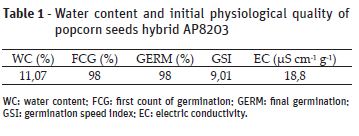
Statistical analyses for vigor, germination and leaching of the exudate from the electric conductivity test, showed positive effect for the period of exposition to the accelerated aging, with data fitting a polynomial regression, once the higher was the exposition period of seeds to an adverse environment with elevated temperature and humidity, the higher was the deterioration rate of seeds. According to Delouche (2002), the period for deterioration process is determined mainly by the interaction between genetic inheritance, the grade of humidity of the seed and the temperature.
It was possible to verify that seeds water content is highly influenced by the relative humidity and high temperature (Figure 1), according to the aging period. As the aging period increased, seeds water content increased until 120 hours of aging period.
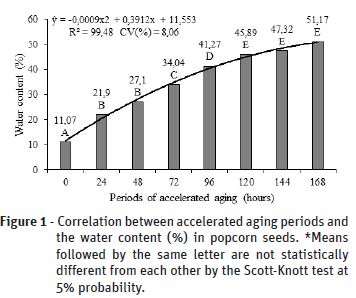
This may have propitiated a higher deterioration of seeds resulting in lower membrane integrity and/or less selectivity, allowing higher access of water into the cells. These results agree with observations registered by Santos et al. (2004) and Sponchiado et al. (2014), which verified that seeds of beans and white oat, respectively, exhibited higher proportions of swollen seeds in lots of lower physiological quality at the end of the soaking period.
Seeds of popcorn evaluated by the germination test showed reduction in the number of normal seedlings with higher exposition periods of accelerated aging (Figure 2). This fact was already expected, once the higher the exposition period to the accelerated aging, the higher the rate of deterioration (Binotti et al., 2008). This process is a consequence of seeds exposition to adverse conditions of high temperature and relative humidity, environmental factors considered as the most associated with the deterioration of seeds.
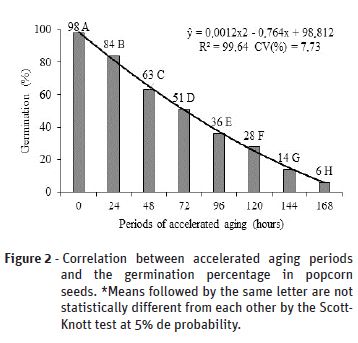
Seed aging results in metabolic alterations during the germination process, including the respiratory metabolism and alterations in the membrane structure, synthesis of proteins and nucleic acids, and DNA metabolism (Vázquez et al., 1991), in addition to promote a delay in the whole germination process, reduce the growth of embryos and increase susceptibility to environmental stresses, eventually causing loss of viability.
It is possible to verify a drastic reduction of seed germination after 72 hours of artificial aging, showing the final effect of deterioration (Figure 2). Artificial aging is based in the fact of deterioration rates of seeds are accelerated according to the exposition period to high levels of temperature and relative humidity of the air, thus explaining the higher reduction in the percentage of normal seedlings.
Accelerated aging also influenced negatively the germination speed index, as showed in Figure 3. This fact arises from seed degeneration, once the higher the exposition of seeds to aging periods, the higher will be the loss of vigor and consequently, lower will be the capacity of seeds to establish a population of seedlings rapidly, uniformly and adequately.
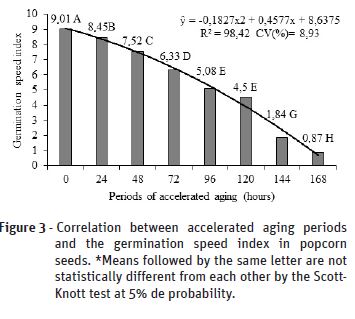
With deterioration, an increase of leaching of cellular constituents from seeds water soaking occurs, due to the loss of integrity of the cell membrane systems. Direct immersion in water causes a rapid water entry into the cells; once it reduces the period needed for membrane reorganization, an event required to guarantee cellular compartmentalization (Silva & Villela, 2011).
There was an increase in the release of electrolytes with the increasing exposition period of seeds (Figure 4). Such electrolyte release is directly related to seed vigor, once the higher the value of electric conductivity, the lower will be the vigor of seeds.
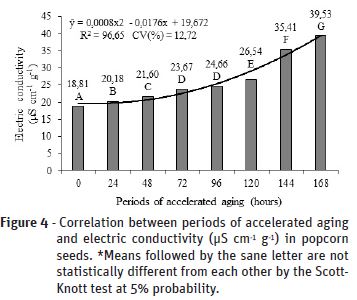
There was a significant difference for all aging periods, being the period of 168 hours the one which most reduced seed vigor. The increase in leachates shows that adverse conditions of humidity and temperature to which seeds were exposed results in loss of membrane and cellular constituents integrity and in reduced capacity of reparation from damages caused to the seeds (Binotti et al., 2008). It is to emphasize that until the period of 72 hours seeds still showed the capacity to regenerate and reorganize its membranes.
According Copeland & McDonald (2001), the deterioration degree of seeds is associated to the concentration of seeds exudates in the solution, which are the reflex of membrane degradation. It is important to emphasize that, according to Delouche (2002), damages in membranes are initial events of degenerative alterations in seeds. Also, according to Ribeiro et al. (2009), shorter exposition periods of popcorn seeds, may be used to identify more accentuated differences between seed lots, and longer exposition periods are more adequate to differentiate lots of less contrasting physiological quality. However, this ability diminishes from 72 hours exposition and above, as can be evidenced by the reduction of germination and vigor (Figures 2 and 3).
Braccini et al. (1999) also referred tendencies of germination reduction as the exposition period increased (from 24 to 72 hours), while experimenting with accelerated aging in different cultivars of soybean. Tagliaferri et al. (2001) also verified that soybean seeds, form different cultivars, submitted to a temperature of 42 oC during 24, 48, 72 and 96 hours, showed higher deterioration index for periods above 48 hours.
With the disintegration of the membrane systems in cell organelles, evidenced by the progressive increase in leachate quantities, seeds become more susceptible to the deleterious effects of O2, which promote oxidation of compounds and form enzymatic activity, which according to Bewley & Black (1994), promote faster consumption of cell reserves. The gradual reduction of seeds viability and vigor promoted by the stressing conditions during the period of accelerated aging may be observed by the results of the evaluated characteristics. This is due to a higher consumption of reserves, resulting from the accelerated metabolic activity under these conditions.
The length of the aerial portion and roots (Figures 5 e 6) of seedlings showed a reduction starting at 24 hours of aging and above. This may be related with the activity of certain enzymes which may influence metabolic activities and therefore, promote higher growth, verified by the increase of the hypocotyl and the primary root under a short exposition period with elevated temperature (Binotti et al., 2008). At 72 hours of aging it was verified that values for the hypocotyl and the roots length decreased, due to the higher deterioration of seeds and lower reparation capacity from damages caused to the seed by the increased exposition period of artificial aging.
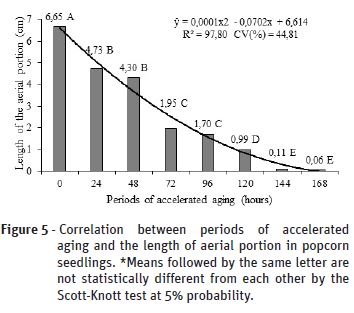
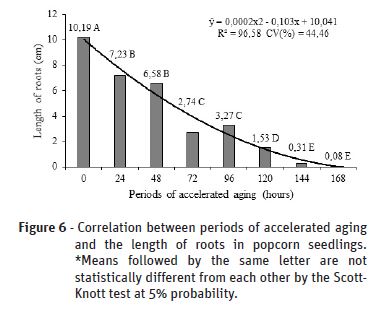
For the last aging period practically, no development of the hypocotyl and roots was observed. Tests evaluating the length of seedlings or its parts have been considered efficient to detect differences in physiological potential of seeds from various species (Nakagawa, 1999). Additionally, these results may have a close association with the emergence percentages of seedlings in the field (Vanzolini et al., 2007).
Carneiro & Guedes (2002) stressed that interpretation of the accelerated aging test to evaluate the physiological potential has been focused mainly in the calculation of the final percentage of germination (normal seedlings), which measures may be associated or not with results from other tests performed after a determined period of seed storage, or with the emergence of seedlings in the field.
Results from accelerate aging tests are usually understood by the degree of tolerance to the adverse conditions of temperature and relative humidity, mainly expressed by the survival of seeds and not necessarily by the reduction of rates in chemical reactions which determine germination velocity and the rate of seedling growth events of deterioration which precede seeds death (Guedes et al., 2011). Consequently, those authors suggested studies focused to determine the possibility to interpret the test of accelerated aging by the evaluation of the germination velocity and seedling growth, supplementing the traditional proceeding of determination of the normal seedlings percentage. Therefore, the present work allowed to verify that seeds loss of viability results from important metabolic events, with deterioration being expressed in many ways, which may prevent germination according to Guedes et al. (2011).
As showed in Table 2, there was significant differences between aging periods and the levels of imbedding solution leachates during electric conductivity. Concerning the test of potassium leachates, it was possible to verify a differentiation of aging periods regarding seeds vigor. It was observed that starting at 72 hours of aging an increase of potassium ions occurs, corroborating with the decreasing in germination and vigor of seeds. However, periods of 144 and 168 hours showed the highest quantities of solution leachates, displaying lower seed vigor.
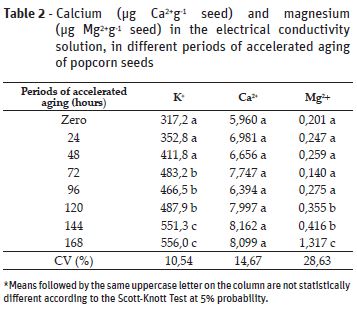
This is elucidated by the fact that this test has a similar principle than the electric conductivity, based in the cellular membrane integrity of seeds, with a difference: while in electric conductivity the total quantity of ions released during soaking is determined, in potassium leaching only solution leached potassium ions are quantified, once this is the main inorganic leached ion from seeds during soaking (Kikuti et al., 2008). Zucareli et al. (2013) verified that potassium was the most leached ion among the elements evaluated in sweet corn seeds, as observed also in wheat seeds by Favarato et al. (2011).
Regarding calcium contents, there was no difference between aging periods; therefore, the evaluation is not efficient to evaluate such ion concerning vigor in popcorn seeds (Table 2). These results agree with Zucareli et al. (2013) and Barbieri et al. (2012) in sweet wheat and rice, respectively. However, the leachate test for magnesium showed significant results for quantification of aging periods regarding vigor, with the period of 168 hours of accelerated aging differing statistically from the other treatments, showing higher quantities of leachates and consequently, less seed vigor (Table 2). These results agree with observations registered by Binotti et al. (2008), demonstrating that increasing aging periods result in a lower physiological quality and higher levels of leachates in the exudate of the electric conductivity test.
CONCLUSIONS
Germination and vigor of popcorn seeds and the quantity of leachates in the electric conductivity test are influenced by the increasing exposition period to the accelerated aging process.
The exposition period of seeds to the accelerated aging process, starting form 72 hours, produces results which are reflected in the potential of seed vigor and the seeds leachates.
References
Barbieri, A.P.P.; Menezes, N.L.; Conceição, G.M. & Tunes, L.M. (2012) - Teste de lixiviação de potássio para a avaliação do vigor de sementes de arroz. Revista Brasileira de Sementes, vol. 34, n. 1, p. 117-124. http://dx.doi.org/10.1590/S0101-31222012000100015 [ Links ]
Bertolin, D.C.; Eustáquio de Sá, M. & Moreira, E.R. (2011) - Parâmetros do teste de envelhecimento acelerado para determinação do vigor de sementes de feijão. Revista Brasileira de Sementes, vol. 33, n. 1, p. 104-112. http://dx.doi.org/10.1590/S0101-31222011000100012 [ Links ]
Bewley, J.D. & Black, M. (1994) - Seeds: physiology of development and germination. 2a ed. New York: Plenum Press. 445 p. [ Links ]
Binotti, F.F.S.; Haga, K.I.; Cardoso, E.D.; Alves, C.Z.; Sá, M.E. & Arf, O. (2008) - Efeito do período de envelhecimento acelerado no teste de condutividade elétrica e na qualidade fisiológica de sementes de feijão. Acta Scientiarum Agronomy, vol. 30, n. 2, p. 247-254. http://dx.doi.org/10.1590/S1807-86212008000200014 [ Links ]
Brasil (2009) - Regras para análise de sementes. Brasília, Ministério da Agricultura, Pecuária e Abastecimento. Secretaria de Defesa Agropecuária. 399 p.
Braccini, A.L.; Reis, M.S.; Sediyama, C.S.; Scapim, C.A. & Braccini, M.C.L. (1999) - Avaliação da qualidade fisiológica de sementes de soja, após o processo de hidratação-desidratação e envelhecimento acelerado. Pesquisa Agropecuária Brasileira, vol. 34, n. 6, p. 1053-1066. http://dx.doi.org/10.1590/S0100-204X1999000600018 [ Links ]
Carneiro, J.W.P. & Guedes, T.A. (2002) - Dinâmica de ocorrências germinativas em amostras de sementes envelhecidas artificialmente. Informativo Abrates, vol. 12, n. 1-3, p. 44-51. [ Links ]
Catão, H.C.R.M. & Caixeta, F. (2017) - Physiological, isozyme changes and image analysis of popcorn seeds submitted to low temperatures. Journal of Seed Science, vol. 39, n. 3, p. 234-243. http://dx.doi.org/10.1590/2317-1545v39n3169853 [ Links ]
Copeland, L.O. & McDonald, M.B. (2001) - Principles of seed science and technology. 4a ed. New York: Chapman and Hall, 467 p. [ Links ]
Delouche, J. (2002) - Germinação, deterioração e vigor da semente. Seed News, n. 6, p. 24-31. [ Links ]
Dutra, S. & Vieira, R.D. (2004) - Envelhecimento acelerado como teste de vigor para sementes de milho e soja. Ciência Rural, vol. 34, n. 3, p. 715-721. [ Links ]
Favarato, L.F.; Rocha, V.S.; Espindula, M.C.; Souza, M.A. & Paula, G.S. (2011) - Teste de lixiviação de potássio para avaliação da qualidade em sementes de trigo. Revista Brasileira de Ciências Agrárias, vol. 6, n. 4, p. 670-674. http://dx.doi.org/10.5039/agraria.v6i4a1547 [ Links ]
Ferreira, D.F. (2011) - Sisvar: a computer statistical analysis system. Ciência e Agrotecnologia, vol. 35, n. 6, p. 1039-1042. http://dx.doi.org/10.1590/S1413-70542011000600001 [ Links ]
Guedes, R.S.; Alves, E.U.; Oliveira, L.S.B.; Andrade, L.A.; Gonçalves, E.P. & Melo, P.A.R.F. (2011) - Envelhecimento acelerado na avaliação da qualidade fisiológica de sementes de Dalbergia nigra (Vell.) Fr. All. Semina: Ciências Agrárias, vol. 32, n. 2, p. 443-450. http://dx.doi.org/10.5433/1679-0359.2011v32n2p443 [ Links ]
Guiscem, J.M.; Farias, A.S.; Figueiredo, R.T.; Chaves, M.A.S.; Figueiredo, B.T.; Pereira, C.F.; Aráujo, J.R.G. & Martins, M.R. (2010) - Teste de frio e envelhecimento acelerado na avaliação de vigor de sementes de feijão-frade. Revista de Ciências Agrárias, vol. 33, n. 2, p. 182-191. [ Links ]
Kikuti, H.; Medina, P.F.; Kikuti, A.L.P. & Ramos, N.P. (2008) - Teste de lixiviação de potássio para avaliação do vigor de sementes de amendoim. Revista Brasileira de Sementes, vol. 30, n. 1, p. 10-18. http://dx.doi.org/10.1590/S0101-31222008000100002 [ Links ]
Maguire, J.D. (1962) - Speed of germination-aid in selection and evaluation for seedling emergence and vigour. Crop Science, vol. 2, n. 1, p. 176-177. [ Links ]
Marcos Filho, J. (1999) - Teste de envelhecimento acelerado. In: Krzyzanowski, F.C.; Vieira, R.D. & França Neto, J.B. (Eds.) - Vigor de sementes: conceitos e testes. Londrina: Abrates, p. 1-24. [ Links ]
Nakagawa, J. (1999) - Testes de vigor baseados no desempenho das plântulas. In: Krzyzanoski, F.C.; Vieira, R.D. & França Neto, J.B. (Eds.) - Vigor de sementes: conceitos e testes. Londrina: Abrates, p. 2-24. [ Links ]
Ohlson, O.C.; Krzyzanowski, F.C.; Caieiro, J.T. & Panobianco, M. (2010) - Teste de envelhecimento acelerado em sementes de trigo. Revista Brasileira de Sementes, vol. 32, n. 4, p. 118–124. http://dx.doi.org/10.1590/S0101-31222010000400013 [ Links ]
Ribeiro, D.M.; Bragança, S.M.; Goneli, A.L.D.; Dias, D.C.F.S. & Alvarenga, E.M. (2009) - Teste de condutividade elétrica para avaliar o vigor de sementes em milho-pipoca (Zea mays L.). Revista Ceres, vol. 56, n. 6, p. 772-776. [ Links ]
Santos, C.M.R.; Menezes, N.L. & Villela, F.A. (2004) - Alterações fisiológicas e bioquímicas em sementes de feijão envelhecidas artificialmente. Revista Brasileira de Sementes, vol. 26, n. 1, p. 110-119. http://dx.doi.org/10.1590/S0101-31222004000100017 [ Links ]
Silva, K.R.G. & Villela, F.A. (2011) - Pré-hidratação e avaliação do potencial fisiológico de sementes de soja. Revista Brasileira de Sementes, vol. 33, n. 2, p. 331-345. http://dx.doi.org/10.1590/S0101-31222011000200016 [ Links ]
Silva, V.N.; Zambiasi, C.A.; Tillmann, M.A.A.; Menezes, N.L. & Villela, F.A. (2014) - Condução do teste de condutividade elétrica utilizando partes de sementes de feijão. Revista de Ciências Agrárias, vol. 37, n. 2, p. 206-213. [ Links ]
Sponchiado, J.C.; Souza, C.A. & Coelho, C.M.M. (2014) - Teste de condutividade elétrica para determinação do potencial fisiológico de sementes de aveia branca. Semina: Ciências Agrárias, vol. 35, n. 4 supl., p. 2405-2414. http://dx.doi.org/10.5433/1679-0359.2014v35n4Suplp2405 [ Links ]
Tagliaferri, C.; Rangel, O.J.P.; Lopes, J.C.; Martins-Filho, S.; Capucho, M.T. & Lima, J.S.S. (2001) - Avaliação de genótipos de soja (Glycine max L. Merrill) através do teste de envelhecimento acelerado. Informativo Abrates, vol. 11, n. 2, p. 228. [ Links ]
Vazquez, G.H.; Cardoso, R.D. & Peres, A.R. (2014) - Tratamento químico de sementes de milho e o teste de condutividade elétrica. Bioscience Journal, vol. 30, n. 3, p. 773-781. [ Links ]
Vanzolini, S.; Araki, C.A.S.; Silva, A.C.M.T. & Nakagawa, J. (2007) - Teste de comprimento de plântula na avaliação da qualidade fisiológica de sementes de soja. Revista Brasileira de Sementes, vol. 29, n. 2, p. 90-96. http://dx.doi.org/10.1590/S0101-31222007000200012 [ Links ]
Vázquez, E.; Montiel, F. & Vázquez-Ramos, J.M. (1991) - DNA ligase activity in deteriorated maize axes during germination: a model relating defects in DNA metabolism in seeds to loss of germinability. Seed Science Research, vol. 1, n. 2, p. 269-273. https://doi.org/10.1017/S0960258500000994 [ Links ]
Zucareli, C.; Brzezinski, C.R.; Abati, J.; Henning, F.A.; Ramos Junior, E.U. & Nakagawa, J. (2013) - Lixiviação de íons potássio, cálcio e magnésio para determinação do vigor em sementes de milho doce. Informativo Abrates, vol. 23, n. 3, p. 56-60. [ Links ]
Received/recebido: 2018.10.16
Received in revised form/recebido em versão revista: 2018.10.24
Accepted/aceite: 2018.10.24














